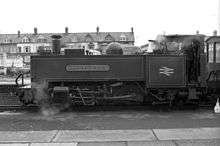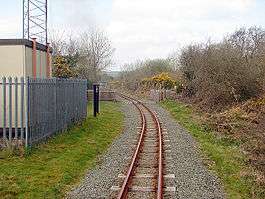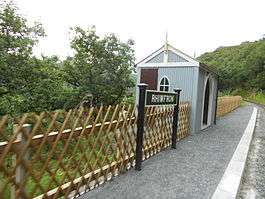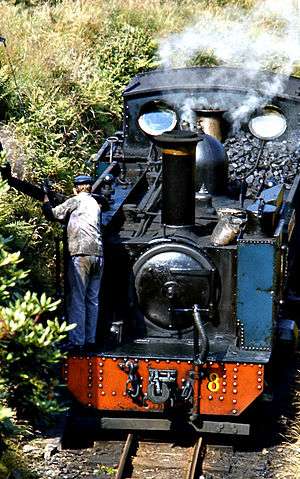Vale of Rheidol Railway
Rheilffordd Cwm Rheidol | |
|---|---|
 | |
|
Locomotive No. 8 Llywelyn on the climb to Devil's Bridge | |
| Locale | Ceredigion, Wales |
| Terminus |
Aberystwyth Devil's Bridge |
| Coordinates | 52°24′40″N 4°04′45″W / 52.41114°N 4.07909°WCoordinates: 52°24′40″N 4°04′45″W / 52.41114°N 4.07909°W |
| Commercial operations | |
| Name | Vale of Rheidol Light Railway |
| Built by | Engineer: James Szlumper |
| Original gauge | 1 ft 11 1⁄2 in (597 mm) |
| Preserved operations | |
| Owned by | Phyllis Rampton Narrow Gauge Railway Trust |
| Operated by | Vale of Rheidol Railway Limited |
| Stations | 4 stations 5 halts |
| Length | 11 3⁄4 miles (18.91 km) |
| Preserved gauge | 1 ft 11 3⁄4 in (603 mm) |
| Commercial history | |
| Opened |
August 1902 (freight only) 22 December 1902 (passenger) |
| 1913 | Taken over by Cambrian Railways |
| 1923 | Great Western Railway Grouping |
| 1948 | Became part of British Railways |
| 1968 | Became the last steam on British Rail |
| Preservation history | |
| 1989 | Privatised |
| Headquarters | Aberystwyth |
| Vale of Rheidol Railway | ||||||||||||||||||||||||||||||||||||||||||||||||||||||||||||||||||||||||||||||||||||||||||||||||||||||||||||||||||||||||||||||||||||||||||||||||||||||||||||||||||||||||||||||||||||||||||||||||||||||||||||||||||||||||
|---|---|---|---|---|---|---|---|---|---|---|---|---|---|---|---|---|---|---|---|---|---|---|---|---|---|---|---|---|---|---|---|---|---|---|---|---|---|---|---|---|---|---|---|---|---|---|---|---|---|---|---|---|---|---|---|---|---|---|---|---|---|---|---|---|---|---|---|---|---|---|---|---|---|---|---|---|---|---|---|---|---|---|---|---|---|---|---|---|---|---|---|---|---|---|---|---|---|---|---|---|---|---|---|---|---|---|---|---|---|---|---|---|---|---|---|---|---|---|---|---|---|---|---|---|---|---|---|---|---|---|---|---|---|---|---|---|---|---|---|---|---|---|---|---|---|---|---|---|---|---|---|---|---|---|---|---|---|---|---|---|---|---|---|---|---|---|---|---|---|---|---|---|---|---|---|---|---|---|---|---|---|---|---|---|---|---|---|---|---|---|---|---|---|---|---|---|---|---|---|---|---|---|---|---|---|---|---|---|---|---|---|---|---|---|---|---|
Legend | ||||||||||||||||||||||||||||||||||||||||||||||||||||||||||||||||||||||||||||||||||||||||||||||||||||||||||||||||||||||||||||||||||||||||||||||||||||||||||||||||||||||||||||||||||||||||||||||||||||||||||||||||||||||||
| ||||||||||||||||||||||||||||||||||||||||||||||||||||||||||||||||||||||||||||||||||||||||||||||||||||||||||||||||||||||||||||||||||||||||||||||||||||||||||||||||||||||||||||||||||||||||||||||||||||||||||||||||||||||||
| ||||||||||||||||||||||||||||||||||||||||||||||||||||||||||||||||||||||||||||||||||||||||||||||||||||||||||||||||||||||||||||||||||||||||||||||||||||||||||||||||||||||||||||||||||||||||||||||||||||||||||||||||||||||||
The Vale of Rheidol Railway (Welsh: Rheilffordd Cwm Rheidol) is a 1 ft 11 3⁄4 in (603 mm) narrow gauge heritage railway, opened in 1902, that runs for 11 3⁄4 miles (18.9 km) between Aberystwyth and Devil's Bridge in the county of Ceredigion, Wales.[1]
From 1968 until 1989, when it was the first part of British Rail to be privatised, it was the sole steam-operated line on the nationalised British Rail network.
Unlike most other preserved railways in the United Kingdom, the Vale of Rheidol Railway did not have a period of closure between its operation as part of the national rail system and becoming a heritage railway, and has operated a service for tourists throughout its life.
History
A narrow gauge railway in the area of Aberystwyth was first proposed after the initial route planned for the Manchester and Milford Railway, from Llanidloes to Aberystwyth via Devil's Bridge, was altered, and then abandoned, before construction started.[2]
The original primary purpose of the line was to carry timber (for pit props in the South Wales valleys) and lead ore from the Rheidol Valley to the sea and the main line railway at Aberystwyth. Many lead mines in the valley were producing ore at the end of the 19th century. Following an Act of Parliament in 1897, it was not possible to raise finance as quickly as expected, and construction commenced in 1901. To save money, rock was hand-hewn rather than blasted. Construction was overseen by the chief engineer, Sir James Szlumper, although he left day-to-day affairs in the hands of the main contractor employed. It was during construction that the ex-Plynlimon and Hafan Tramway locomotive Talybont, regauged from 2 ft 3 in (686 mm) to 1 ft 11 3⁄4 in (603 mm) and renamed Rheidol, arrived on the line, where it would remain for the rest of its life.
In the London Daily News of 9 August 1901 it was reported that the line was expected to be completed by March 1902[3] and the directors were hopeful for a free grant from the Treasury for the Aberayron Extension.
By the time the railway was ready to open in 1902, lead mining in Ceredigion was in steep decline. However a significant growth in tourism was under way, and the carriage of passengers soon became the principal traffic of the railway. It opened for mineral traffic in August 1902 and for passengers on 22 December 1902,[4] using two 2-6-2T locomotives built by Davies and Metcalfe and the aforementioned Rheidol, built by Bagnall.[5] The original stations were Aberystwyth (located on Park Avenue), Llanbadarn, Capel Bangor, Nantyronen and Devil's Bridge (Pontarfynach). A short branch ran along the Rheidol's bank to the harbour. The final construction cost was reported as £60,000[6] (equivalent to £5,874,513 in 2015).[7]
The line was moderately successful as a tourist railway although local passenger and freight traffic remained limited, to the extent that the harbour branch was very little used throughout its existence. However, efforts were made to develop the tourist service over the summer seasons with the construction of open-sided carriages and such was the level of the tourist trade the locomotive Palmerston had to be hired from the Festiniog Railway over a number of summers pre-war.
Towards the end of its life as an independent company, the half year revenue of the company as reported in February 1911 was £3,660[8] (equivalent to £336,144 in 2015).[7]
As a branch of the Cambrian Railways
In 1912 the use of electric power from the river was considered, but plans for such (never likely to have taken place due to lack of capital) were abandoned when the line was absorbed by the Cambrian Railways on 1 July 1913.[9] The Cambrian Railways obtained the company for the seemingly bargain price of £27,311[10] (equivalent to £2,423,615 in 2015),[7] when compared with the construction cost of £69,267 (equivalent to £6,781,832 in 2015).[7] The onset of war in 1914 closed the lead mine and passenger services were reduced, which put the final nail in the coffin of any planned improvements.[11] The reduction in Passenger services and the need for timber for the war effort meant that freight became the principal revenue source for a short while.[11] The line also served Army training camps in the valley, and such was traffic that as had occurred before the war, the locomotive Palmerston had to be hired over several summers during wartime.
Under Great Western Railway control
On 1 January 1922, as part of the Cambrian Railways the line was grouped into the Great Western Railway (GWR).[11] A new station was opened immediately adjacent to the town's main standard gauge station.[5] The GWR invested quite significantly in its new asset - Rheidol and one of the two Davies & Metcalfe locomotives were scrapped and the other given a full overhaul. Three brand new locomotives, built at the GWR's works in Swindon arrived on the line in 1923/24 and proved a great success. New open cars were built to replace the home-made examples used by the VoR and Cambrian, and in 1938 the closed carriages were entirely replaced by high quality modern replacements.
However, the GWR also recognised the line's limited traffic outside of its tourist operations. In 1932 the last remaining original locomotive was scrapped, in 1933 the harbour branch was formally abandoned, and in 1936 the line became a summer operation only. The entire line was closed for the duration of World War II, though maintenance continued. After closure for over 6 years, the railway reopened in June 1946.[12]
Nationalisation

The Great Western Railway became part of the Western Region of British Railways on 1 January 1948 and the line continued to operate a tourist service.[13] In the 1950s local managers ensured that the VoR remained well looked after, the coaches carrying BR's express livery and the locomotives gaining names in 1956 and fully lined express livery for the following season.
In the 1960s, the ex-Cambrian network of Western Region was transferred to the London Midland Region and a question mark hung over the VoR's future for some time until the Minister for Transport, Barbara Castle, confirmed that it would remain open and in British Rail's hands. In 1968, the line was rerouted in Aberystwyth to run into the former standard gauge Carmarthen line platforms of the main station, which had been abandoned in 1964. This meant that the route of the line no longer dog-legged and did not have to cross Park Avenue by a Level Crossing..[14] The former standard gauge locomotive shed was also refurbished and adapted into use for the VoR.[15] The former station site is now occupied by a supermarket and the former route was sold for redevelopment.
In the late 1960s the line's locomotives and rolling stock were (somewhat controversially) painted into British Rail's corporate blue livery with the famous 'coming or going' logo emblazoned on loco and coach sides. This was gradually improved in the 1970s with lining and other embellishments, until in the 1980s a return to historical liveries was countenanced. This, occasional visits from Mountaineer of the Ffestiniog Railway and special trains such as Santa specials and even simulated Wild-West style Indian attacks helped to keep the line's attraction fresh to the public, despite declining investment which resulted in insufficient maintenance - which culminated in a spectacular (though injury-free) derailment near Aberffrwd in 1986.
Privatisation
The line was privatised in 1989, the first part of BR to be privatised, being sold to Peter Rampton and Tony Hills (the late owner and General Manager of the Brecon Mountain Railway).[16] In 1996, Rampton and Hills split their partnership, with Hills retaining control of the Brecon, and the Rheidol being sold to a trust formed by Rampton, the Phyllis Rampton Narrow Gauge Railway Trust.[17] Unusually, the VoR operated completely without volunteers for approximately the first 20 years of its privatised operation.
The railway today
The railway continues to operate as a tourist railway, generally operating between Easter and the end of October with extra services during February Half Term and Santa Specials at Christmas.
Various developments have taken place since 2010 as the railway has enjoyed a period of greater investment and more dynamic management. Volunteers have been employed in a limited capacity keeping Station areas tidy and fresh, and station facilities have been enhanced along the line, with raised platforms being built at the principal crossing and terminal stations, the first time in its history the railway has had these. New waiting shelters have also been provided at some locations. The Aberystwyth station has been significantly redeveloped to present a more accessible route from the line's car park, though at the expense of the route from the town and mainline station.
The line now boasts a substantial purpose-built workshop building at Aberystwyth, which has resulted in the line taking on contract work and more locomotives of the Phyllis Rampton Narrow Gauge Trust emerging at Aberystwyth for occasional use.
At Devil's Bridge station, the siding that followed the northern boundary of the station has been disconnected from the rest of the railway, and is now used in the summer months to provide driving experiences for visitors for a fee.
In 2014 the line received its first visitor since the 1980s, when Palmerston returned from the Ffestiniog for the first time since its original periods of hire around the First World War, and in 2015 the line held its first ever enthusiast-orientated gala event.
The route
There are nine stations. Whilst all trains generally stop at block stations, for operational reasons, the other intermediate stations are treated as request stops. The journey takes one hour in each direction and much of it at a gradient of 1 in 50 (2%).
| Image | Name | Notes |
|---|---|---|
 |
Aberystwyth | The headquarters of the railway are at Aberystwyth where it shares a terminus with the standard gauge main line, trains leaving from the former Carmarthen bay platform. The original mainline engine shed houses the locomotives and carriages and until recently provided workshop facilities. A large new purpose-built workshop building is now operational. |
.jpg) |
Llanbadarn | Llanbadarn is a request stop serving the village of Llanbadarn Fawr. There are no surfaced platforms or buildings. In the 1950s when the National Eisteddfod was held in Llanbadarn, the VoR operated an intensive shuttle service from Aberystwyth to Llanbadarn, carrying tens of thousands of passengers in a very short period. |
 |
Glanyrafon | Glanyrafon Halt is a request stop serving the nearby industrial estate. There are no surfaced platforms or buildings. |
 |
Capel Bangor | Capel Bangor station is close to the village of Capel Bangor. In the mid-20th century a carriage shed here provided additional accommodation for the line's stock, and a new shed built roughly on the same location was added in 2005. New platforms and a station building (a replica of the original) were built in 2012. |
 |
Nantyronen | Nantyronen is a request stop. Up trains pause briefly here to allow the locomotive to take on water. A new platform and station building were completed in 2013. |
 |
Aberffrwd | Aberffrwd station is close to the hamlet of Aberffrwd. A new platform and station building were completed in 2013. |
 |
Rheidol Falls | Rheidol Falls is a request stop. A new platform and station building were completed in 2013. |
 |
Rhiwfron | Rhiwfron is a request stop. A new platform and station building were completed in 2013. |
| Devil's Bridge | Devil's Bridge station is the railway's eastern terminus. It is a short walk from the Mynach Waterfalls. | |

When the lead mines were being worked there was an aerial cableway linking them with Rhiwfron.
The railway had a branch line which ran to Aberystwyth Harbour, principally for freight services. The Harbour Branch became redundant with the predominance of tourist passenger operations and was closed and lifted. Little evidence of it remains today.
Operation
The line has three steam locomotives for passenger trains and one diesel locomotive, although in recent years these have been supplemented by additional locomotives owned by The Phyllis Rampton Narrow Gauge Trust. The railway also owns 16 carriages and a 4-wheeled brake van.
The railway is single track with passing loops at Capel Bangor and Aberffrwd which are operated by the train crew. The line is worked by tokens, which authorise the driver to enter a single line section. Tokens are provided for:-
- Aberystwyth to Capel Bangor
- Capel Bangor to Aberffrwd
- Aberffrwd to Devil's Bridge
The Duty Officer regulates train running, overseeing the staff signalling system and giving permission for trains to enter the single line sections, recording train movements on the Train Graph and ensuring trains are formed of an appropriate number of carriages.
Gallery
 No 8 (like sister engines 7 and 9) had probably the oddest application of the rail blue livery during the 1970s
No 8 (like sister engines 7 and 9) had probably the oddest application of the rail blue livery during the 1970s Train with No 7 leaving Aberystwyth station
Train with No 7 leaving Aberystwyth station No. 9 Prince of Wales at Devil's Bridge railway station
No. 9 Prince of Wales at Devil's Bridge railway station Front view of No. 9 at Devil's Bridge
Front view of No. 9 at Devil's Bridge.jpg) A photograph of the railway
A photograph of the railway.jpg) Grass and sticks have gathered up next to the old tracks
Grass and sticks have gathered up next to the old tracks Prince of Wales on its way to Devil's Bridge
Prince of Wales on its way to Devil's Bridge
See also
- British narrow gauge railways
- Locomotives of the Vale of Rheidol Railway
- Coaching stock of the Vale of Rheidol Railway
- List of British heritage and private railways
- Tourism in Wales
References
- ↑ Johnson 1999, page 15
- ↑ Johnson 2011, page 52
- ↑ "Vale of Rheidol Light Railway". London Daily News. British Newspaper Archive. 9 August 1901. Retrieved 17 September 2016 – via British Newspaper Archive. (subscription required (help)).
- ↑ "The new railway from Aberystwyth to Devil's Bridge". Lancashire Evening Post. British Newspaper Archive. 23 December 1902. Retrieved 17 September 2016 – via British Newspaper Archive. (subscription required (help)).
- 1 2
- ↑ "Light Railway to Devil's Bridge". Gloucestershire Echo. British Newspaper Archive. 23 December 1902. Retrieved 17 September 2016 – via British Newspaper Archive. (subscription required (help)).
- 1 2 3 4 UK CPI inflation numbers based on data available from Gregory Clark (2016), "The Annual RPI and Average Earnings for Britain, 1209 to Present (New Series)" MeasuringWorth.
- ↑ "The revenue of the Vale of Rheidol Light Railway Company". Yorkshire Post and Leeds Intelligencer. British Newspaper Archive. 16 February 1911. Retrieved 17 September 2016 – via British Newspaper Archive. (subscription required (help)).
- ↑ Green 1986, page 26
- ↑ "G.W.R. Official Cross-Examined". Western Daily Press. British Newspaper Archive. 31 May 1924. Retrieved 17 September 2016 – via British Newspaper Archive. (subscription required (help)).
- 1 2 3 Green 1986, page 28
- ↑ "The Rheidol Railway". Banbury Guardian. British Newspaper Archive. 20 June 1946. Retrieved 17 September 2016 – via British Newspaper Archive. (subscription required (help)).
- ↑ Green 1986, page 29
- ↑ Parts of the route may be traced via the Geograph Project as here, for example.
- ↑ Johnson 2011, page 88
- ↑ "The Great British Rail Sale is Over" The Railway Magazine issue 1152 April 1997 pages 24/25
- ↑ Boyd-Hope, Gary (January 2009). "Rheidol revival: 20 years of private enterprise". Steam Railway. 358: 91–5.
Bibliography
- Green, CC (1986). The Vale of Rheidol Light Railway. Wild Swan. ISBN 0-906867-43-6.
- Johnson, Peter (1999). Welsh Narrow Gauge: a view from the past. Ian Allan Publishing. ISBN 0-7110-2654-8.
- Johnson, Peter (2011). An Illustrated History of the Great Western Narrow Gauge. OPC. ISBN 978-0-86093-636-7.
External links
| Wikimedia Commons has media related to Vale of Rheidol Railway. |